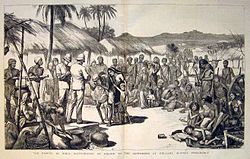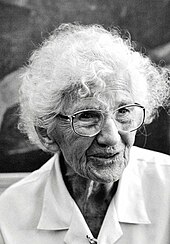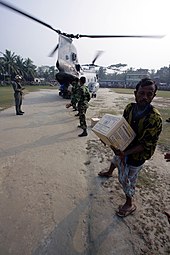Humanitarian principles are a set of principles that governs the way humanitarian response is carried out. The principle is central to establishing and maintaining access to affected populations in natural disasters or complex emergency situations. In disaster management, compliance with the principles are essential elements of humanitarian coordination. The main humanitarian principles have been adopted by the United Nations General Assembly. The four guiding principles are Humanity, Neutrality, Impartiality and Independence.
Defining principles
The
core principles are defining characteristics, the necessary conditions
for humanitarian response. Organizations such as military forces and
for-profit companies may deliver assistance to communities affected by
disaster in order to save lives and alleviate suffering, but they are
not considered by the humanitarian sector as humanitarian agencies as
their response is not based on the core principles.
Core humanitarian principles
Humanity
The
principle of humanity means that all humankind shall be treated humanely
and equally in all circumstances by saving lives and alleviating
suffering, while ensuring respect for the individual. It is the
fundamental principle of humanitarian response.
The purpose of humanitarian action is to protect life, health and
ensure respect for human beings. It also promotes mutual
understanding, cooperation, friendship and peace among all people.
According to the International Federation of Red Cross and Red Crescent
movement, the principle of humanity includes:
• It recalls the origin of the movement: a desire to assist without
discrimination to the wounded during conflict.
• It recalls the double dimension of the movement: national and
international one.
• To protect life and health
• To define the purpose of the movement
Humanitarian Imperative
The Code of Conduct for the International Red Cross and Red Crescent Movement and NGOs in Disaster Relief
(RC/NGO Code) introduces the concept of the humanitarian imperative
which expands the principle of humanity to include the right to receive
and to give humanitarian assistance. It states the obligation of the
international community "to provide humanitarian assistance wherever it
is needed."
Impartiality
Provision of humanitarian assistance must be impartial
and no discrimination on the basis of nationality, race, gender,
religion, political opinion or class. It must be based on need alone.
Priority most be given to the most urgent cases of distress.
To treat everyone the same way without consideration for the
level of suffering or the urgency would not be equitable. Impartiality
means that the only priority that can set in dealing with people that
need help must be based on need and the order of relief must correspond
to the urgency.
For most non-governmental humanitarian agencies (NGHAs), the
principle of impartiality is unambiguous even if it is sometimes
difficult to apply, especially in rapidly changing situations. However,
it is no longer clear which organizations can claim to be humanitarian.
For example, companies like PADCO, a USAID subcontractor, is sometimes
seen as a humanitarian NGO. However, for the UN agencies, particularly
where the UN is involved in peace keeping activities as the result of a
Security Council resolution, it is not clear if the UN is in position to
act in an impartial manner if one of the parties is in violation of
terms of the UN Charter.
Neutrality
For International Red Cross and Red Crescent Movement,
neutrality means not to take sides in hostilities or engage at any time
in controversies of a political, racial, religious or ideological
nature.
The principle of neutrality was specifically addressed to the Red
Cross Movement to prevent it from not only taking sides in a conflict,
but not to "engage at any time in controversies of a political, racial,
religious or ideological nature."
Neutrality can also apply to humanitarian actions of a state.
"Neutrality remains closely linked with the definition which introduced
the concept into international law to designate the status of a State
which decided to stand apart from an armed conflict. Consequently, its
applications under positive law still depend on the criteria of
abstention and impartiality which have characterized neutrality from the
outset."
The application of the word neutrality to humanitarian aid
delivered by UN agencies or even governments can be confusing. GA
Resolution 46/182 proclaims the principle of neutrality, yet as an
inter-governmental political organization, the UN is often engaged in
controversies of a political nature. According to this interpretation,
the UN agency or a government can provide neutral humanitarian aid as
long as it does it impartially, based upon need alone.
Today, the word neutrality is widely used within the humanitarian
community, usually to mean the provision of humanitarian aid in an
impartial and independent manner, based on need alone. Few international
NGOs have curtailed work on justice or human rights issues because of
their commitment to neutrality.
Independence
Humanitarian
agencies must formulate and implement their own policies independently
of government policies or actions. Humanitarian agencies, although there
are auxiliaries in the humanitarian services and subject to the laws of
their countries, must maintain their autonomy from political, economic,
military or any other others and to be able at all times to act in
accordance with the humanitarian principles.
Problems may arise because most NGHAs rely in varying degrees on
government donors. Thus for some organizations it is difficult to
maintain independence from their donors and not be confused in the field
with governments who may be involved in the hostilities. The ICRC,
has set the example for maintaining its independence (and neutrality)
by raising its funds from governments through the use of separate
annual appeals for headquarters costs and field operations.
Additional humanitarian principles
In
addition to the core principles, there are other principles that govern
humanitarian response for specific types of humanitarian agencies such
as UN agencies, the Red Cross and Red Crescent Movement, and NGOs.
Proselytism
The
provision of aid must not exploit the vulnerability of victims and be
used to further political or religious creeds. All of the major
non-governmental humanitarian agencies (NGHAs) by signing up to the
RC/NGO Code of Conduct have committed themselves not to use humanitarian
response to further political or religious creeds.
Universality
Equal
status and share of responsibilities and duties in helping each other.
Solidarity with regard to decision-making regardless of their size or
wealth.
Origin of Humanitarian principles
The
humanitarian principles originated from the work of the International
Committee of Red Cross and the National Red Cross/Red Crescent
Societies. The core principles guided the work of these organizations
before it was adopted by the United Nations. In 1991, the first three
principles (humanity, neutrality and impartiality) were adopted and
endorsed in the General Assembly resolution 46/182. The General Assemble
resolution of 1991 also led to the establishment of the role of the
Emergency Relief Coordinator (ERC). In 2004, the General Assembly
resolution 58/114 added independence as the fourth core principle
essential to humanitarian action. The fourth principle was as result of
co-opting of humanitarian assistance in highly politicized context to
address challenges faced in preserving independence for local partners
and in relation to targeting of beneficiaries and the delivery of need
based services in affected areas. These principles have been adopted by
many international humanitarian organizations working with affected
populations in disaster crisis.
The Inter-Agency Standing Committee has the responsibility of
upholding humanitarian principles globally. This is the body
responsible for bringing together UN agencies, Red Cross Movement and
NGOs working in humanitarian action.
Principles based on field experience in emergencies
All
of the above principles are important requirements for effective field
operations. They are based on widespread field experience of agencies
engaged in humanitarian response. In conflict situations, their breach
may drastically affect the ability of agencies to respond to the needs
of the victims.
If a warring party believes, for example, that an agency is
favoring the other side, or that it is an agent of the enemy, access to
the victims may be blocked and the lives of humanitarian workers may be
put in danger. If one of the parties perceives that an agency is trying
to spread another religious faith, there may be a hostile reaction to
their activities.
Sources
The core principles, found in the Red Cross/NGO Code of Conduct and in GA Resolution 46/182
are derived from the Fundamental Principles of the Red Cross,
particularly principles I (humanity), II (impartiality), III
(neutrality—in the case of the UN), and IV (independence).
Humanitarian accountability
Accountability
has been defined as: "the processes through which an organisation makes
a
commitment to respond to and balance the needs of stakeholders in its
decision making processes and activities, and delivers against this
commitment." Humanitarian Accountability Partnership International adds: "Accountability is about using power responsibly."
Article 9 of the Code of Conduct for the International Red Cross and Red Crescent Movement and NGOs in Disaster Relief
states:
"We hold ourselves accountable to both those we seek to assist and those
from whom we accept resources;" and thus identifies the two major stake
holders: donors and beneficiaries. However, traditionally humanitarian
agencies have tended to practice mainly "upward accountability", i.e.
to their donors.
The experience of many humanitarian agencies during the Rwandan
Genocide, led to a number of initiatives designed to improve
humanitarian assistance and accountability, particularly with respect to
the beneficiaries. Examples include the Sphere Project, ALNAP, Compas, the People In Aid Code of Good Practice, and the Humanitarian Accountability Partnership International, which runs a "global quality insurance scheme for humanitarian agencies."
Additional principles
The
RC/NGO Code also lists a number of more aspirational principles which
are derived from experience with development assistance.
- Agencies should operate with respect to culture and custom
- Humanitarian response should use local resources and capacities as much as possible
- The participation of the beneficiaries should be encouraged
- Emergency response should strive to reduce future vulnerabilities
- Agencies should be accountable to both donors and beneficiaries
- Humanitarian agencies should use information activities to portray victims as dignified human beings, not hopeless objects
The right to life with dignity
The Sphere Project Humanitarian Charter uses the language of human rights to remind that the right to life which is proclaimed in both the Universal Declaration of Human Rights and the International Convention on Civil and Political Rights is related to human dignity.
Vulnerability and behavioral issues
Humanitarian
principles are mainly focused on the behavior of organizations.
However a humane response implies that humanitarian workers are not to
take advantage of the vulnerabilities
of those affected by war and violence. Agencies have the
responsibility for developing rules of staff conduct which prevent abuse
of the beneficiaries.
Sexual exploitation and abuse
One of the most problematic areas is related to the issue of sexual exploitation and abuse
of beneficiaries by humanitarian workers. In an emergency where
victims have lost everything, women and girls are particularly
vulnerable to sexual abuse.
A number of reports which identified the sexual exploitation of
refugees in west Africa prodded the humanitarian community to work
together in examining the problem and to take measures to prevent
abuses. In July 2002, the UN's Interagency Standing Committee (IASC)
adopted a plan of action which stated: Sexual exploitation and abuse by
humanitarian workers constitute acts of gross misconduct and are
therefore grounds for termination of employment. The plan explicitly
prohibited the "Exchange of money, employment, goods, or services for
sex, including sexual favours or other forms of humiliating, degrading
or exploitative behaviour." The major NGHAs as well the UN agencies
engaged in humanitarian response committed themselves to setting up
internal structures to prevent sexual exploitation and abuse of
beneficiaries.
Compliance
Substantial
efforts have been made in the humanitarian sector to monitor compliance
with humanitarian principles. Such efforts include The People In Aid Code of Good Practice,
an internationally recognised management tool that helps humanitarian
and development organisations enhance the quality of their human
resources management. The NGO, Humanitarian Accountability Partnership International, is also working to make humanitarian organizations more accountable, especially to the beneficiaries.
Structures internal to the Red Cross Movement monitor compliance to the Fundamental Principles of the Red Cross.
The RC/NGO Code is self-enforcing. The SCHR
carries out peer reviews among its members which look in part at the
issue of compliance with principles set out in the RC/NGO Code














